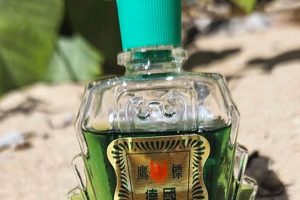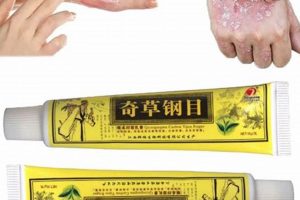A compendium documenting the properties and uses of botanicals within Traditional Chinese Medicine (TCM) represents a foundational text for practitioners. These volumes often detail the characteristics of various plants, their energetic properties (such as warming or cooling), the specific organs or meridians they affect, and appropriate dosages. For instance, a specific entry might describe the use of ginger (, shng jing) for warming the stomach and alleviating nausea.
The significance of these texts lies in their comprehensive approach to health and wellness, rooted in centuries of empirical observation and refinement. They provide a framework for understanding the complex interplay between the body, environment, and natural remedies. Historically, these resources were essential for training doctors and transmitting knowledge from one generation to the next. The continued study of these materials provides insights into potential therapeutic interventions and a deeper appreciation for the holistic principles of TCM.
Understanding these foundational texts is crucial for navigating the broader landscape of Traditional Chinese Medicine. The following sections will delve into specific aspects, including the classification methods employed, the key concepts governing their application, and examples of frequently referenced materials.
The following tips offer guidance on effectively utilizing resources documenting Traditional Chinese Medicine (TCM) pharmacopeia, aiding in comprehension and responsible application of the information contained within.
Tip 1: Prioritize Verified Translations: Utilize translated versions from reputable publishers and academic institutions. Cross-reference information between different translations to ensure accuracy and identify potential discrepancies in interpretation.
Tip 2: Understand Herbal Properties: Master the fundamental properties ascribed to each herb, including its temperature (hot, warm, cool, cold), flavor (sour, bitter, sweet, pungent, salty), and the meridians it enters. These properties guide the selection of herbs for specific conditions.
Tip 3: Recognize Formula Composition Principles: Analyze the structure of classic herbal formulas. Identify the chief herb (the primary ingredient addressing the main pattern), the assistant herbs (aiding the chief herb or addressing secondary symptoms), the adjuvant herbs (harmonizing and moderating the formula), and the envoy herb (guiding the formula to specific meridians or locations).
Tip 4: Study Contraindications: Thoroughly examine contraindications for each herb and formula. Understand potential interactions with pharmaceutical medications, pre-existing health conditions, and pregnancy. Adherence to safety protocols is paramount.
Tip 5: Explore Historical Context: Consider the historical and cultural context in which each volume was written. Understanding the diagnostic paradigms and therapeutic approaches prevalent at the time can provide valuable insights into the intended use of the herbs.
Tip 6: Consult with Qualified Practitioners: These materials are intended for informational and educational purposes. Seeking guidance from a licensed and experienced TCM practitioner is crucial for accurate diagnosis, appropriate herbal selection, and personalized treatment plans.
Tip 7: Embrace Continuous Learning: The study of TCM materia medica is an ongoing process. Engage in continuing education, attend seminars, and participate in discussions with experienced practitioners to deepen one’s understanding and refine clinical skills.
Effective utilization of these resources necessitates a dedicated commitment to rigorous study, critical analysis, and responsible application. The tips provided offer a structured approach to navigating the complexities inherent in Traditional Chinese Medicine pharmacopeia, fostering a deeper comprehension of its principles and practices.
The subsequent discussion will address common misconceptions and explore avenues for further research and professional development in this field.
1. Herbal Properties
The comprehensive documentation of herbal properties within traditional Chinese materia medica forms the very basis for understanding and applying the knowledge contained within these texts. Without a thorough grasp of these properties, effective and safe utilization of the documented therapies is impossible.
- Temperature ( , xng w)
The thermal nature of an herb hot, warm, neutral, cool, or cold significantly influences its therapeutic application. For example, ‘hot’ herbs such as cinnamon (, gu zh) are used to dispel cold and warm the body, while ‘cold’ herbs like rhubarb (, d hung) are employed to clear heat and detoxify. These classifications are critical for selecting herbs that counterbalance imbalances in the body’s energetic state, a core principle of TCM.
- Flavor ( , wi do)
The five flavors sour, bitter, sweet, pungent (acrid), and salty each correspond to specific organ systems and therapeutic actions. Sour herbs like schisandra (, w wi z) are astringent and can stop leakage, while bitter herbs like gentian (, lng dn co) clear heat and dry dampness. The flavor profile guides the practitioner in directing the herb’s effects to the appropriate areas and functions of the body, as described in the traditional literature.
- Meridian Affinity ( , gu jng)
Herbs demonstrate a predilection for entering specific meridians, or energy channels, within the body. This affinity dictates the herb’s primary influence on that particular meridian and its associated organ system. For instance, chrysanthemum (, j hu) is said to enter the Lung and Liver meridians, making it useful for treating conditions related to these organ systems, such as coughs or headaches. Traditional texts meticulously document these meridian affinities, providing a roadmap for targeted therapeutic interventions.
- Actions ( , gng xio)
The documented actions of an herb describe its specific therapeutic effects, such as tonifying Qi, resolving phlegm, promoting blood circulation, or relieving pain. These actions are often described in detail within traditional resources, providing insights into the herb’s clinical applications. An example is dong quai (, dng gu), whose documented actions include tonifying blood and regulating menstruation, making it a key herb in women’s health formulations.
The meticulous cataloging of these characteristics in texts dedicated to traditional pharmacopeia provides a framework for understanding the nuanced effects of each herb. The correct interpretation and application of this information are paramount for achieving desired therapeutic outcomes and ensuring patient safety. Continued study and clinical experience are essential for mastering the intricate knowledge contained within these ancient resources.
2. Formula Composition
Within the context of recorded traditional pharmacopeia, formula composition constitutes a crucial element for understanding therapeutic applications. These texts meticulously document not only individual herbs but, more significantly, the synergistic combinations that form complex prescriptions. Formula composition dictates the overall effect of a remedy, going beyond the properties of individual ingredients to create a unified therapeutic strategy. The strategic pairing of herbs, carefully documented in these historical resources, allows for the targeted treatment of intricate patterns of disharmony. A classic example is the Four Gentlemen Decoction (, S Jn Z Tng), comprising ginseng, atractylodes, poria, and licorice. This formulation is designed to tonify Qi and strengthen the spleen, addressing fatigue and digestive weakness. Each herb plays a specific role, with ginseng as the chief herb, supported by the assistant and adjuvant herbs to enhance its effect and minimize potential side effects.
The understanding of formula composition extends beyond simply listing the ingredients. It requires knowledge of the roles each herb plays within the formulachief, deputy, assistant, and envoyand how these roles interact to achieve the desired therapeutic outcome. The chief herb addresses the principal symptom or disease pattern, while the deputy strengthens the chief herb’s action or addresses a secondary symptom. Assistant herbs moderate the chief herb’s potency, address side effects, or treat concurrent conditions. The envoy herb guides the formula to specific meridians or harmonizes the other ingredients. Furthermore, the ratios of herbs within a formula are carefully considered and documented. Slight variations in these ratios can significantly alter the formula’s effect, shifting its focus or mitigating potential adverse reactions. This precision in formulation is a hallmark of the information found within the ancient texts.
In summary, formula composition is not merely a list of ingredients; it’s a carefully orchestrated therapeutic strategy codified within the pages of TCM materia medica. Understanding the individual roles of herbs, their synergistic interactions, and the critical importance of precise ratios is essential for practitioners seeking to effectively utilize this ancient system of medicine. The study of formula composition provides a profound appreciation for the wisdom and precision of TCM and offers valuable insights into the art of combining natural remedies for optimal health outcomes.
3. Meridian Affinity
Meridian affinity, as documented in a traditional Chinese pharmacopeia, constitutes a fundamental principle guiding herbal selection and application within Traditional Chinese Medicine (TCM). These texts methodically record the specific meridians to which each herb demonstrates a tropism, thereby dictating its primary therapeutic influence within the body’s energetic network. This affinity is not arbitrary; rather, it is rooted in centuries of empirical observation and clinical validation, forming a cornerstone of diagnostic and treatment strategies. The accurate assessment of meridian affinity, as provided in these volumes, directly informs the selection of appropriate herbs to address imbalances within specific organ systems and their corresponding energetic pathways. For instance, an individual experiencing Liver Qi stagnation might benefit from herbs documented to enter the Liver meridian, such as Bupleurum (, Chi H), which is traditionally used to soothe the Liver and alleviate associated symptoms like irritability and distension.
The importance of meridian affinity stems from the TCM perspective that illness arises from disruptions in the flow of Qi (vital energy) within the meridians. By selecting herbs with an affinity for affected meridians, practitioners aim to restore harmonious energy flow and promote healing. This is evident in the use of herbs that enter the Heart meridian to address conditions such as insomnia or palpitations, which are often attributed to imbalances in Heart Qi. The documented meridian affinities in the texts provide a guide for directing the therapeutic action of herbs to the precise location where they are most needed. Practical application necessitates a comprehensive understanding of both the theoretical framework of meridian theory and the detailed information provided within the materia medica. Misinterpretation of meridian affinities can lead to ineffective treatment or, in some cases, adverse reactions.
In conclusion, the relationship between meridian affinity and the documentation in traditional pharmacopeia is intrinsic to the practice of TCM. These records provide a systematic framework for understanding the energetic properties of herbs and their targeted therapeutic actions. A thorough comprehension of meridian affinity, coupled with accurate diagnosis and careful consideration of individual patient needs, is essential for the safe and effective application of herbal medicine within the TCM paradigm. The ongoing study and preservation of these traditional resources are critical for maintaining the integrity and efficacy of this ancient healing art.
4. Dosage Guidelines
Dosage guidelines documented within traditional Chinese herbal literature constitute a critical component for the safe and effective application of herbal remedies. These guidelines, often meticulously detailed, reflect centuries of clinical experience and empirical observation.
- Standardized Units of Measurement
Traditional texts often employ historical units of measurement (e.g., qian, fen, cun) that require conversion to modern equivalents for accurate dosing. Discrepancies in these conversions can lead to significant variations in the administered quantity, highlighting the need for careful attention to detail and cross-referencing with reliable conversion charts. Improper conversions can lead to either sub-therapeutic doses, rendering treatment ineffective, or excessively high doses, potentially causing adverse effects.
- Consideration of Individual Factors
Herbal compendia frequently acknowledge the need to adjust dosages based on individual patient characteristics, such as age, body weight, and overall constitution. Children and elderly patients typically require lower doses due to their physiological vulnerabilities. Individuals with weakened constitutions or pre-existing health conditions also warrant a more cautious approach to dosing. Failure to account for these factors can result in adverse reactions or exacerbate existing health problems.
- Herbal Processing Methods
The method by which an herb is processed significantly impacts its potency and therapeutic properties, thereby influencing dosage requirements. Processing techniques such as stir-frying, steaming, or calcining can alter the chemical composition of the herb, modifying its effects. Dosage guidelines often specify the appropriate processing method for a given herb, and deviations from these recommendations can lead to unpredictable outcomes. Unprocessed or improperly processed herbs may lack the desired therapeutic effect or, conversely, exhibit increased toxicity.
- Formulation Considerations
Dosage guidelines for individual herbs must be considered within the context of the overall herbal formula. The synergistic or antagonistic interactions between different herbs in a formula can influence the bioavailability and efficacy of each component. Therefore, adjustments to individual herb dosages may be necessary to optimize the formula’s overall therapeutic effect. The principles of formula construction, including the roles of chief, deputy, assistant, and envoy herbs, should inform dosage decisions to ensure a balanced and harmonious therapeutic outcome.
The accurate interpretation and application of dosage guidelines from documented traditional pharmacopeia are paramount for ensuring patient safety and maximizing therapeutic efficacy. These guidelines must be viewed as a starting point, subject to individual patient assessment and careful clinical judgment, emphasizing the need for practitioners to possess a thorough understanding of both the material medica and the principles of TCM.
5. Contraindications
The systematic documentation of contraindications represents a critical safety component within any comprehensive traditional Chinese herbal literature. These texts meticulously detail specific conditions, patient populations, or concurrent therapies that render the use of particular herbs or formulas inappropriate, potentially harmful, or even life-threatening. The inclusion of contraindications underscores the recognition that natural substances, while possessing therapeutic potential, are not inherently benign and may interact negatively with individual physiologies or existing medical interventions. For instance, many herbal compendia explicitly caution against the use of certain blood-tonifying herbs in individuals with acute infections, as such herbs could inadvertently exacerbate the inflammatory process. Similarly, the concurrent use of anticoagulant medications and herbs known to affect blood clotting carries a significant risk of hemorrhage, necessitating careful assessment and avoidance.
The identification and adherence to contraindications are paramount for ensuring patient safety and preventing adverse events. These cautions are not arbitrary but rather are grounded in centuries of clinical observations and refined through rigorous pharmacological analysis. A failure to heed documented contraindications can result in a range of complications, from mild allergic reactions to severe organ damage or even death. Consider, for example, the use of herbs containing aristolochic acid, which have been linked to kidney failure and urothelial cancer. Competent practitioners thoroughly review the contraindication sections of credible herbal texts before prescribing any herbal remedy to mitigate risk.
In conclusion, contraindications constitute an indispensable element of any authoritative Chinese herbal text. The systematic documentation and meticulous adherence to these safety guidelines are crucial for the responsible and ethical application of traditional Chinese medicine. By recognizing and respecting the potential for harm, practitioners can minimize the risk of adverse events and ensure that herbal therapies are used judiciously and safely. The continued study and updating of these contraindications, based on both traditional knowledge and modern scientific research, are essential for maintaining the integrity and efficacy of herbal medicine in contemporary healthcare.
Frequently Asked Questions Regarding Documented Chinese Herbal Information
The following questions address common inquiries and potential misconceptions surrounding the use and interpretation of texts related to Traditional Chinese Medicine (TCM) pharmacopeia.
Question 1: Are all herbal texts equally reliable sources of information?
No. Reliability varies considerably based on factors such as authorship, publication date, and adherence to established TCM principles. Texts published by reputable institutions or translated by qualified scholars are generally considered more trustworthy. Cross-referencing information from multiple sources is recommended.
Question 2: Can I use online resources to self-diagnose and treat medical conditions with herbs?
Self-diagnosis and treatment based solely on online information is strongly discouraged. Accurate diagnosis requires a comprehensive assessment by a qualified TCM practitioner. The application of herbal remedies should be individualized based on specific diagnostic patterns and individual needs.
Question 3: Are the dosages listed in historical texts directly applicable in modern clinical practice?
Not necessarily. Historical units of measurement require careful conversion to modern equivalents. Furthermore, factors such as herb processing methods, patient constitution, and potential herb-drug interactions necessitate individualized dosage adjustments under the guidance of a qualified practitioner.
Question 4: Are herbal remedies safe because they are “natural”?
The term “natural” does not equate to safety. Herbal remedies can possess potent pharmacological effects and may interact negatively with certain medical conditions or pharmaceutical medications. Adherence to documented contraindications and consultation with a qualified practitioner are crucial.
Question 5: Can herbal remedies cure all diseases?
No. Herbal remedies are not a panacea. While they can be effective for a range of conditions, they are best utilized within a holistic treatment approach that addresses lifestyle factors, dietary habits, and emotional well-being. Certain conditions may require conventional medical intervention.
Question 6: How can I ensure the quality and authenticity of herbal products?
Source herbal products from reputable suppliers who adhere to Good Manufacturing Practices (GMP) and provide certificates of analysis verifying the identity and purity of the herbs. Beware of counterfeit products or those of dubious origin, as these may pose significant health risks.
In summary, the responsible utilization of texts related to Traditional Chinese Medicine pharmacopeia requires careful consideration of source reliability, adherence to dosage guidelines, and recognition of potential contraindications. Consultation with a qualified practitioner is essential for accurate diagnosis, individualized treatment plans, and the safe application of herbal remedies.
The following section will explore future trends and emerging research in the field of Traditional Chinese Medicine.
Conclusion
The preceding discussion has illuminated the significance and complexity inherent in materials relating to traditional herbal medicine. These resources provide a framework for understanding the properties, applications, and potential risks associated with herbal remedies. A thorough comprehension of key aspects, including herbal properties, formula composition, meridian affinity, dosage guidelines, and contraindications, is essential for responsible and effective utilization of this ancient medical system.
Continued rigorous study and critical analysis of these primary source materials, coupled with ongoing research and clinical validation, are imperative for ensuring the integrity and advancing the safe integration of traditional practices into modern healthcare. The information contained within represents a valuable legacy, demanding respectful and informed stewardship to unlock its full potential for the benefit of human health.







